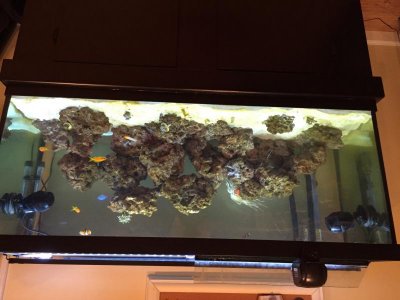ChameleonNYSea
New member
Hey all,
I recently (1 week ago) dosed the appropriate amount of Chemiclean in order to combat a terrible Cyano outbreak. I thought that I was going to lose most of my corals due to them being smothered by the Cyano. In order to prevent another terrible Cyano outbreak, I installed two 600 gph power heads to bring my total water flow to 1600 GPH in a 75 gallon tank. After 72 hours, I performed a 20% water change as directed per instructions.
Now, since all of the Cyano is gone, I am experiencing a diatom bloom. (The tank is 3 1/2 months old). I am planning on getting 5 Cerriths to help knock that out also.
Fast forward to today, and some of my corals are not looking to great. My Xenia stopped pulsing, and they are retracted (they still retain their grayish color, and have not turned black). My star polyps have also retracted. 70% of one of my zoanthid colonies is closed up. (The other colony seems to be doing fine). Part of my hammer coral is retracting, but another head on the same skeleton seems to be doing fine. My torch coral seems to be doing fine. Additionally, a Condy anemone is retracting more than usual (I know I will get some hate regarding this, but it has been in the tank February and has survived so far.) (It usually cycles through puffing up and retracting, but this seems like a prolonged retracting phase). My rainbow acans seem to be doing fine also.
Does anyone have any ideas about why this is happening? I don't have a protein skimmer, but just replaced my carbon to try and soak up all of the extra Chemiclean in the system. Is there still some Chemiclean that may be affecting the corals? Are they having trouble adjusting to the new waterflow? Any other reasons? Does it seem like my tank is going to crash soon? Did the Cyano knock them out for good?
Thanks.
I recently (1 week ago) dosed the appropriate amount of Chemiclean in order to combat a terrible Cyano outbreak. I thought that I was going to lose most of my corals due to them being smothered by the Cyano. In order to prevent another terrible Cyano outbreak, I installed two 600 gph power heads to bring my total water flow to 1600 GPH in a 75 gallon tank. After 72 hours, I performed a 20% water change as directed per instructions.
Now, since all of the Cyano is gone, I am experiencing a diatom bloom. (The tank is 3 1/2 months old). I am planning on getting 5 Cerriths to help knock that out also.
Fast forward to today, and some of my corals are not looking to great. My Xenia stopped pulsing, and they are retracted (they still retain their grayish color, and have not turned black). My star polyps have also retracted. 70% of one of my zoanthid colonies is closed up. (The other colony seems to be doing fine). Part of my hammer coral is retracting, but another head on the same skeleton seems to be doing fine. My torch coral seems to be doing fine. Additionally, a Condy anemone is retracting more than usual (I know I will get some hate regarding this, but it has been in the tank February and has survived so far.) (It usually cycles through puffing up and retracting, but this seems like a prolonged retracting phase). My rainbow acans seem to be doing fine also.
Does anyone have any ideas about why this is happening? I don't have a protein skimmer, but just replaced my carbon to try and soak up all of the extra Chemiclean in the system. Is there still some Chemiclean that may be affecting the corals? Are they having trouble adjusting to the new waterflow? Any other reasons? Does it seem like my tank is going to crash soon? Did the Cyano knock them out for good?
Thanks.

